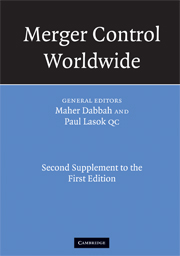Book contents
- Frontmatter
- Contents
- List of contributors
- Table of cases
- Table of legislation
- Introduction to the Second Supplement
- Introduction to the First Supplement
- 1 Argentina
- 2 Armenia
- 3 Australia
- 4 Austria
- 5 Belgium
- 6 Brazil
- 7 Canada
- 8 Chile
- 9 China
- 10 Denmark
- 11 European Union
- 12 Germany
- 13 Greece
- 14 Iceland
- 15 Italy
- 16 Japan
- 17 Republic of Korea
- 18 Malta
- 19 Mexico
- 20 The Netherlands
- 21 New Zealand
- 22 Norway
- 23 Singapore
- 24 Spain
- 25 Switzerland
- 26 Taiwan
- 27 Ukraine
- 28 United Kingdom
- 29 United States of America
- Index
4 - Austria
Published online by Cambridge University Press: 30 July 2009
- Frontmatter
- Contents
- List of contributors
- Table of cases
- Table of legislation
- Introduction to the Second Supplement
- Introduction to the First Supplement
- 1 Argentina
- 2 Armenia
- 3 Australia
- 4 Austria
- 5 Belgium
- 6 Brazil
- 7 Canada
- 8 Chile
- 9 China
- 10 Denmark
- 11 European Union
- 12 Germany
- 13 Greece
- 14 Iceland
- 15 Italy
- 16 Japan
- 17 Republic of Korea
- 18 Malta
- 19 Mexico
- 20 The Netherlands
- 21 New Zealand
- 22 Norway
- 23 Singapore
- 24 Spain
- 25 Switzerland
- 26 Taiwan
- 27 Ukraine
- 28 United Kingdom
- 29 United States of America
- Index
Summary
Introduction
The Austrian Cartel Act 1988 (Kartellgesetz, KartG) and the Austrian Competition Act (Wettbewerbsgesetz, WettbG) were amended in June 2005. The new Cartel Act 2005 and the amended Competition Act entered into force on 1 January 2006. With respect to the Austrian merger regime governed by the Cartel Act and the Competition Act, the amendments brought about only minor modifications. Changes include higher turnover thresholds, the exclusivity of turnover-based fines, a leniency programme and the competency of the Federal Competition Authority (the “FCA”) for filing notifications. These changes are flagged and discussed in the text that follows.
Notification requirements
In the new Cartel Act 2005, concentrations are defined in Section 7.
The concept of concentration
According to Section 7(2) of the new Cartel Act 2005, cooperative full-function joint ventures are regarded as concentrations within the meaning of the Austrian merger regime while Section 7(4) provides that intra-group mergers are exempt from merger control.
The Cartel Act 2005 abolished the distinction between concentrative and cooperative full-function joint ventures insofar as both forms of joint ventures will qualify as concentration within the meaning of the Austrian merger regime.
Notification thresholds
In the new Cartel Act 2005, the thresholds are set out in Section 9(1). The new Cartel Act 2005 brought about the following changes:
The turnover thresholds must not simply be met, but exceeded.
The second turnover threshold (combined turnover in Austria) has been increased to €30 million.
The third turnover threshold (of each undertaking concerned worldwide) has been increased to €5 million.
- Type
- Chapter
- Information
- Merger Control WorldwideSecond Supplement to the First Edition, pp. 18 - 20Publisher: Cambridge University PressPrint publication year: 2008

